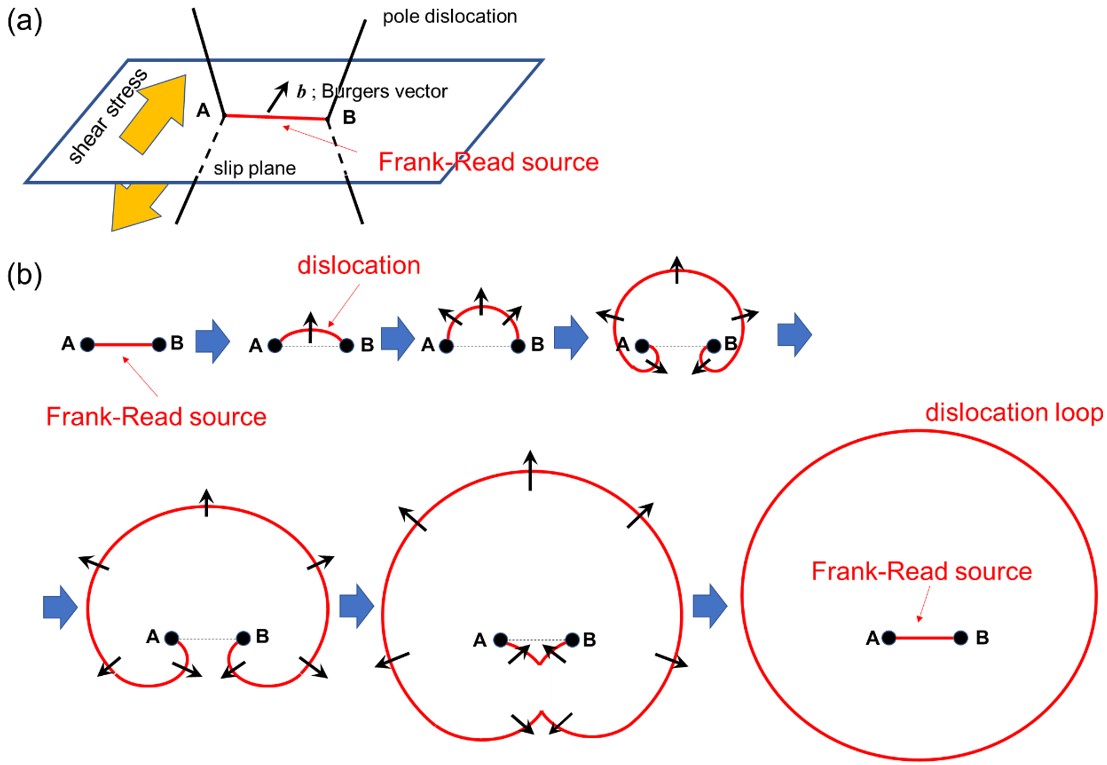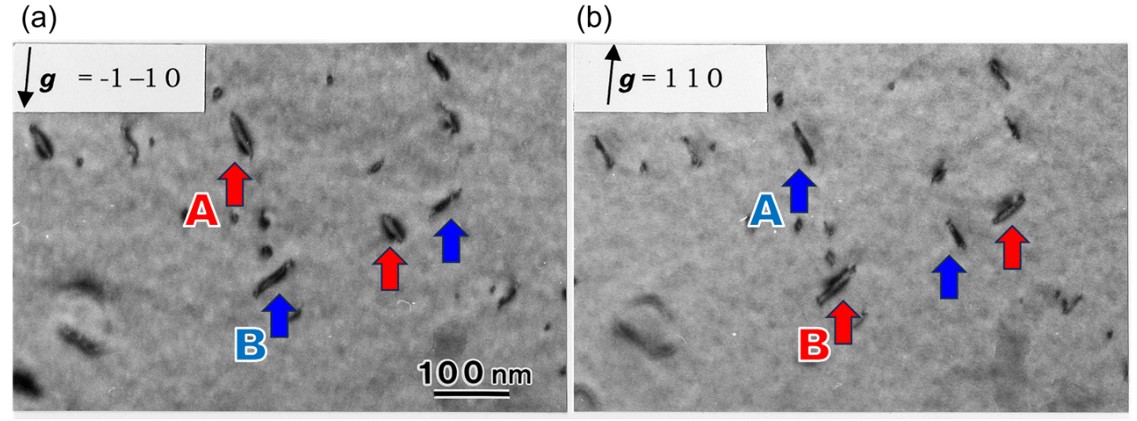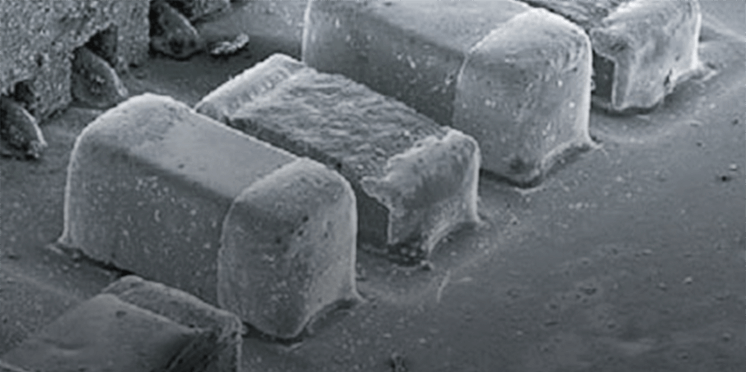dislocation loop
dislocation loop
“Dislocation loop” is a closed loop of a dislocation line. There are two types of the dislocation loops: “shear dislocation loop” and “prismatic dislocation loop”.
The shear dislocation loop is created by applying shear stress to an existing dislocation. This dislocation loop causes deformation of a material, and is important to understand work hardening of materials.
The prismatic dislocation loop is a dislocation produced around a planer cluster of interstitial atoms or vacancies, which are introduced respectively by doping impurities or radiation exposure to a material. The prismatic dislocation loop is important to understand the luminous characteristic of semiconductors and the brittle fracture of reactor materials.
Shear dislocation loop
The Burgers vector of the shear dislocation loop is parallel to the plane where the dislocation loop exists. Fig. 1 shows “Frank-Read mechanism”, which is a mechanism to multiply the shear dislocation loop [1]. A dislocation pinned at both ends A and B on the slip plane (the red line in Fig. 1(a), (b)) is called a Frank-Read source. When shear stress is applied to this dislocation (Frank-Read source), the dislocation expands upward along the slip plane and becomes larger. When the dislocation expands further, it wraps downward and touches itself to form a dislocation loop as shown in Fig. 1(b). The original dislocation returns to its initial state (Frank-Read source). Continued shear stress leads to the repeated generation of dislocation loops (called “multiplication of dislocations”).
Dislocations multiplied by the shear dislocation loop formation mechanism move and escape from the material when an external force is applied. As a result, the material deforms plastically. (transition from elastic to plastic deformation, is called “yield phenomena”) When these dislocations become entangled with other dislocations, they cause to harden materials (work hardening).

Fig. 1. Formation of a shear dislocation loop by the Frank-Read mechanism.
(a) Birds-eye-view of the Frank-Read source on a slip plane. The Burgers vector of dislocation is in the slip plane. The dislocation is pinned at points A and B.
(b) Schematic of dislocation loop creation by the Frank-Read mechanism. When a shear stress is applied to the dislocation line AB, the dislocation expands upward and then, wraps around, and touch itself to create a dislocation loop. The dislocation line AB returns to its initial state.
Prismatic dislocation loop
The Burgers vector of the prismatic dislocation loop is perpendicular to a plane where the dislocation loop exists. Fig. 2 shows a schematic of two types of the prismatic dislocation loop; vacancy type (a) and interstitial type (b). Arrows indicate the directions of the Burgers vectors. White dotted circles show atomic vacancies and red circles show the atoms (interstitials) introduced between the lattices.
The type of the prismatic dislocation loop (vacancy type or interstitial type) and its behaviors (generation, growth/shrinkage, migration, coalescence, annihilation) are important to understand not only the electrical and luminous characteristics of semiconductors doped with hetero-elements, but also deterioration processes of mechanical properties of materials for atomic reactors and nuclear fusion reactors used under irradiation of high-energy particles [2, 3].
Observation example of Prismatic dislocation loop
Whether the type of the prismatic dislocation loop is the vacancy type or the interstitial type is determined by using diffraction contrast of dislocation loops appearing in a bright-field- or dark-field-image (inside-outside contrast method [5]).
Fig. 3 shows an example of how prismatic dislocation loops are seen in TEM images when positive g and negative -g reflections are excited. A typical example of the inside-contrast (the dislocation image is produced inside the real dislocation, resulting in a small image) is indicated by blue arrows, and a typical example of the outside-contrast (the dislocation image is produced outside the real dislocation, resulting in a large image) is indicated by red arrows.
The dislocation loops indicated by A in Fig.3 (a) and (b) are the same dislocation loops. They show outside-contrast when g = -1-1 0 is excited (a), and inside-contrast when g = 1 1 0 is excited (b). The analysis determined the dislocation loop A to be the interstitial type [4].
The dislocation loops B were also determined to be the interstitial type, but showed opposite contrast to A. This is because the inclination of the dislocation loops against the incident electron beam is opposite to A.

Fig. 2. Schematic of the prismatic dislocation loop. (a) Vacancy type and (b) Interstitial type. Arrows indicate the directions of the Burgers vectors. White dotted circles show atomic vacancies and red circles show matrix atoms or hetero-atoms introduced between the lattices.

Fig. 3. Bright-field images (exhibiting diffraction contrast) of prismatic dislocation loops in an iron specimen produced by irradiating helium ions [4], taken near the [001] incidence at an accelerating voltage of 200 kV. Figs (a) and (b) were taken from the same area respectively with opposite reflections g = -1-1 0 and g = 1 1 0. Dislocation loops A and B change their contrast from outside-contrast to inside-contrast when the sign of the exciting reflection is reversed. Utilizing this behavior, these dislocation loops were determined to be the interstitial type.
These images were taken with a JEOL JEM-2010 combined with an ion-accelerator, installed at Shimane University.
(By Professor Kazuto Arakawa, Shimane University)
References
[1] J. P. Hirth and J. Lothe, Theory of dislocations (2nd ed.), Wiley, New York (1982).
[2] K. Arakawa et al., Science 318, 956-959 (2007).
[3] K. Arakawa and H. Mori, Material (Japanese) 48, 1, 11-15 (2009), in Japanese.
[4] K. Arakawa et al. J. Appl. Phys. 89, 4752-4757 (2001).
[5] M. L. Jenkins and M.A. Mark, Characterization of radiation damage by transmission electron microscopy (2nd ed.), Institute of Physics Publishing, Bristol (2000).
Related Term(s)
Term(s) with "dislocation loop" in the description
Are you a medical professional or personnel engaged in medical care?
No
Please be reminded that these pages are not intended to provide the general public with information about the products.




